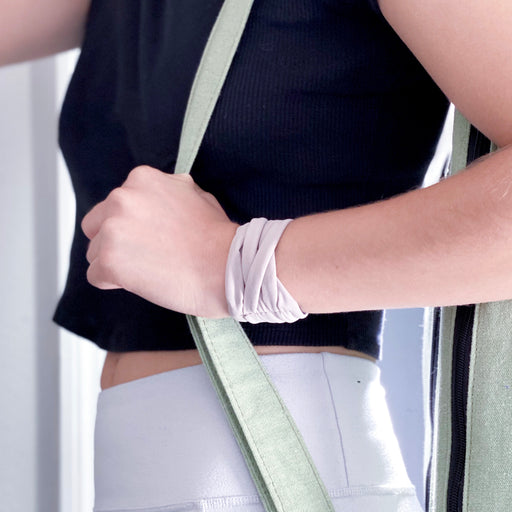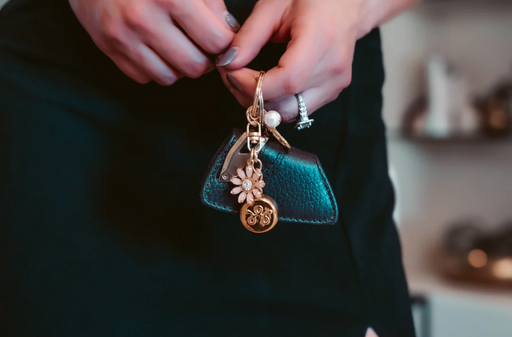Meet Ray Hamilton, invisaWear CTO & Co-Founder

Meet invisaWear's Chief Technology Officer (CTO), Ray Hamilton. We recently had a chance to interview Ray and he shared more about his personal journey to launching invisaWear, his biggest piece of advice to those thinking about taking the plunge into entrepreneurship and his greatest professional achievement to date.
Q: Tell us more about you and your personal journey to launching invisaWear.
Ray: My main role with invisaWear is to be the Chief Technology Officer (CTO) which focuses on designing the technology behind our product and overseeing all product development teams including hardware design, firmware development, mobile app development, mechanical and industrial design, and QA/QC testing teams. Now that we've officially launched the product my role has shifted to focus more on operations to manage our supply chain and contract manufacturing partnerships to maintain scalable operations. I got my degree in Electrical Engineering from UMass Lowell and my background is mainly in hardware, however I'm also a co-founder which means I also play a major role in almost every aspect of our company and it's decisions. Rajia and I have always worked really well together which has helped us tremendously in making critical decisions that got us to where we are today.
Q: From a technology standpoint, when launching invisaWear, what aspect was the most important?
Ray: The beauty is in the simplicity of the design. From the outside it just looks like a beautiful piece of jewelry, but the inside is what contains our life saving technology. When we first came up with the design, we included all of these bells and whistles, one of which was a vibration motor. The vibration feature was suppose to indicate to the user that they had sent an alert, and it would also vibrate to send status updates such as when somebody was coming to their rescue. Believe it or not, the charm used to be triple the size it is now because of this vibration feature, and it's something we thought was really important. When we actually went out and spoke to real people to get their opinion the response was unanimous. Everyone said they probably wouldn't even feel it vibrate if they're in an emergency because they're going to be so nervous and frantically pressing the button. The most important thing we discovered was that people wanted the design to be as small as possible or else they wouldn't want to wear it. It was a tough decision but we ended up removing a lot of the added features to make it smaller because we listened to what people actually cared about rather than what we thought they cared about.
Q: What area of technology excites you most?
Ray: This is a tough question because there are so many things that excite me about our technology. If I had to choose I'd have to say that our ability to work directly with 9-1-1 is truly state of the art technology and eliminates the need for monthly subscriptions. The original problem we were trying to solve was that people didn't have enough time to get to their phone, unlock it, and dial 9-1-1 during an emergency. In our research we stumbled upon an even bigger problem, which was that even if you could reach your phone to call for help, 9-1-1 often cannot locate where you are when calling from a cell phone. Sadly 10,000 people die each year because of this problem. We developed a partnership with RapidSOS to help send accurate location data to 9-1-1 and connect them with your loved ones. We often find that police and first responders are some of our biggest fans because they know how difficult it can be to locate people during an emergency. Our product helps solve this problem, and it already has proven to help save someone's life.
Q: Where did you get your entrepreneurial spirit?
Ray: I got my first job while I was in high school working at a small Dunkin' Donuts in my hometown. I was quickly promoted after 6 months and worked my way up the ladder to an assistant manager while I was going to college. I always had a strong work ethic, but I also took pride in my work even though it was a job that many people considered "just their first job" and did not take it as serious. For me it was about being able to make a difference, even if it was something as little as putting a smile on people's faces as they start their day. My manager saw that in me from the very beginning, and we both were soon recruited to help manage of the top 10 busiest Dunkin' Donuts out of the franchise's 200+ locations. It was a weird feeling being just 19 years old and helping manage a staff of 40 people, many of which were twice my age, but people saw how hard I worked and I was able to earn their respect. It was not long after that I was offered to manage my own store, but I decided turn it down to keep pursuing my degree in Electrical Engineering because I knew that technology was my real passion. I'll always credit my experience with Dunkin' Donuts as the start to my entrepreneurial journey because it taught me the skills I needed to accomplish many of our goals with starting invisaWear.
Q: What are the biggest obstacles you’ve had to overcome as an entrepreneur?
Ray: I think one of the hardest things we did was raising our first round of funding. When we first got started we had no idea about all of the different types of funding available, so we spent a lot of time going to events to learn about them and networking with people to ask for their advice. There was so much planning involved and we didn't want to raise a single penny until we knew exactly what it was going to be spent on. Unfortunately as a tech company it requires a lot of upfront capital in order to get started so we weren't able to bootstrap and fund it ourselves. One of the first obstacles we faced was that we had a 'chicken and egg' problem. Investors said that consumer products are so risky, so they wanted to see sales and more traction before they were interested in making an investment. Well that didn't make sense to us because we didn't have a product yet in order to get sales, and in order to have a product we needed money to develop it. How in the world were we suppose to get to market without raising money from investors? I'm not going to lie, it was tough. I was a still finishing my senior year in college as a broke college student during our first year with invisaWear. We worked 17 hours a day not making a single penny and Rajia and I spent many nights not eating dinner because we couldn't afford to eat. My friends thought I was crazy for working so much especially considering this was during a time when invisaWear was still 'just an idea'. But that didn't matter to us. What if someday this product helps save someone's life? So we kept working, and eventually we were able to find the right investors that were passionate about what we were doing and believed in us because of how hard we worked. I'll never forget our first investors that took a risk and helped us get to where we are today to helping save people's lives.
Q: Tell us about your typical work day.
Ray: Everyday in the life of an entrepreneur is completely different, and since things move so quickly in a startup my day-to-day has changed drastically over the years. I've worked for a Fortune 500 company with 70,000 people, I've worked for a mid-sized company with 4,000 people, and now I've worked with a company when it used to be just 2 people. My perspective on any company has changed after going through this entire experience because I know even a company with 70,000 people had to start out with the founders working tirelessly to literally lift it up off of ground out of nothing but an idea. We've gone through phases of coming up with a business plan, doing customer discovery, developing a prototype, raising money, launching a crowdfunding campaign, finding manufacturers, bringing a product to market, answering customer support questions and traveling across the entire country to get the word out as quickly as possible. I truly believe these are some of the fundamentals every founder should go through if they want to be successful.
Q: What three words would you use to describe yourself?
Ray: A lot of people say that I'm quiet. They mean this literally because I often don't speak loud enough, but it's also because I'm always thinking.
I'm also a perfectionist. I'm always trying to find the best possible solution, and I always tell myself 'there has to be a better way' when encountering problems.
Ever since I was little I've always been a fixer. Often times fixing things just comes natural to me, but I also think it's something I've learned from my dad growing up after always breaking things around the house and he'd always find a way to fix it.
Q: What’s your biggest piece of advice to anyone who is thinking about taking the plunge into entrepreneurship?
Ray: Don't be afraid to ask for advice. You'd be surprised to find out how willing people are to help you. I don't think there's ever been a time where we asked someone for their advice and they said no.
Q: What has been your greatest professional achievement to date?
Ray: There are countless accomplishments we've made over the past few years, but words will never be able to describe how it felt when I found out we helped save someone life. This is why we started this, this is why I made so many sacrifices and worked countless late nights over the past several years. My passion for helping make a difference in someone life is what it has always been about for me.
Q: Favorite quote?
Ray: "Some people dream of success, others stay up all night to achieve it."



















